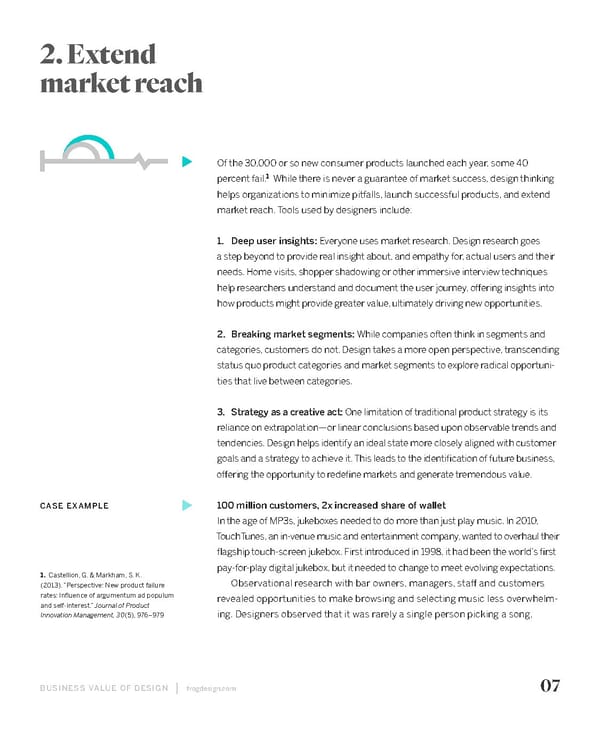2. Extend market reach Of the 30,000 or so new consumer products launched each year, some 40 1 percent fail. While there is never a guarantee of market success, design thinking helps organizations to minimize pitfalls, launch successful products, and extend market reach. Tools used by designers include: 1. Deep user insights: Everyone uses market research. Design research goes a step beyond to provide real insight about, and empathy for, actual users and their needs. Home visits, shopper shadowing or other immersive interview techniques help researchers understand and document the user journey, offering insights into how products might provide greater value, ultimately driving new opportunities. 2. Breaking market segments: While companies often think in segments and categories, customers do not. Design takes a more open perspective, transcending status quo product categories and market segments to explore radical opportuni- ties that live between categories. 3. Strategy as a creative act: One limitation of traditional product strategy is its reliance on extrapolation—or linear conclusions based upon observable trends and tendencies. Design helps identify an ideal state more closely aligned with customer goals and a strategy to achieve it. This leads to the identification of future business, offering the opportunity to redefine markets and generate tremendous value. CASE EXAMPLE 100 million customers, 2x increased share of wallet In the age of MP3s, jukeboxes needed to do more than just play music. In 2010, TouchTunes, an in-venue music and entertainment company, wanted to overhaul their flagship touch-screen jukebox. First introduced in 1998, it had been the world’s first pay-for-play digital jukebox, but it needed to change to meet evolving expectations. 1. Castellion, G. & Markham, S. K. (2013). “Perspective: New product failure Observational research with bar owners, managers, staff and customers rates: Influence of argumentum ad populum revealed opportunities to make browsing and selecting music less overwhelm- and self-interest.” Journal of Product Innovation Management, 30(5), 976–979 ing. Designers observed that it was rarely a single person picking a song, BUSINESS VALUE OF DESIGN frogdesign.com | 07
 The Business Value of Design Page 6 Page 8
The Business Value of Design Page 6 Page 8